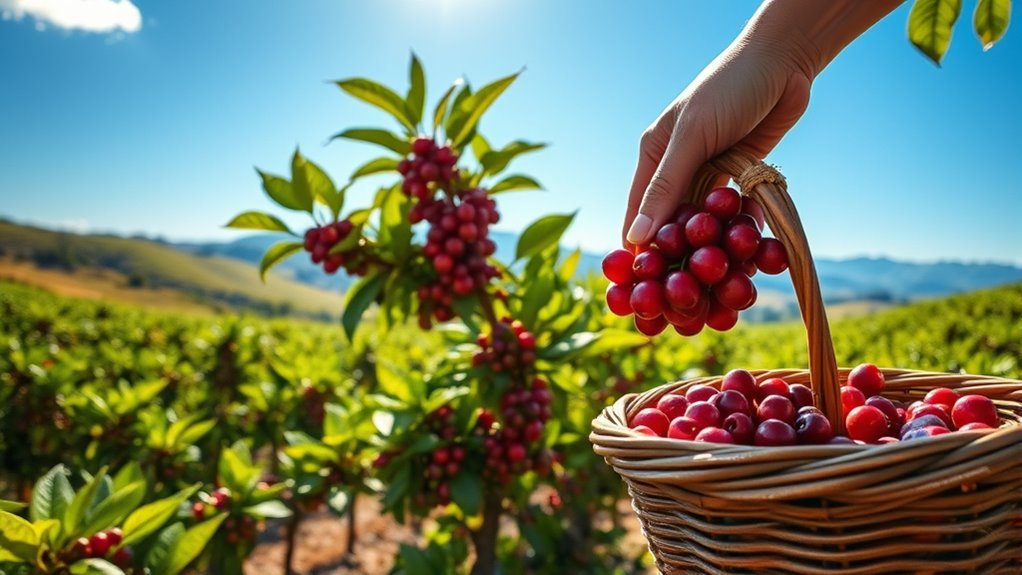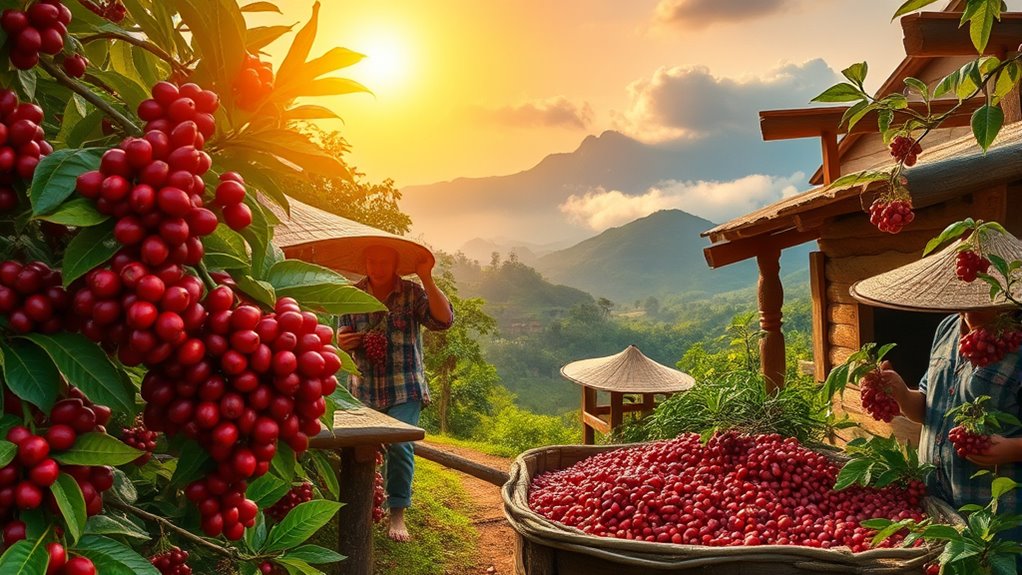The journey of coffee from farm to cup starts on lush coffee farms in the Bean Belt, where hand-picked cherries are harvested. After processing and drying, the beans are milled for quality. Next, they’re exported and roasted, transforming them into the fragrant coffee you enjoy. Grinding the beans just right is key for flavor extraction, and brewing shows off their unique profiles. Discover the intricate details behind each step and how they come together for your perfect cup.
Key Takeaways
- Coffee begins its journey on farms in the Bean Belt, where trees take 3 to 4 years to produce ripe cherries.
- Harvesting methods, like hand-picking, ensure only the best cherries are selected for quality.
- Processing involves drying, hulling, and sorting to create high-quality green coffee beans.
- Once packaged, beans are shipped to roasters, with transit taking 2 to 4 months.
- Roasting transforms green beans into coffee, with grind size and brewing method affecting the final flavor.
The Coffee Farm: Where It All Begins

At the heart of every great cup of coffee lies the coffee farm, where the journey begins. Nestled in the Bean Belt, these farms cultivate coffee trees that flourish in high elevations with rich soil.
It takes about 3 to 4 years for these trees to produce coffee cherries, which turn a deep ruby red when ripe and ready for harvesting. Each cherry contains two precious seeds that we recognize as coffee beans.
The cultivation of coffee involves labor-intensive processes, often requiring hand-picking to guarantee only the best cherries are selected. Many farms embrace sustainable practices, promoting ecosystem health while enhancing flavor quality. This dedication to ethical sourcing aligns with the growing consumer demand for transparency in coffee production.
Coffee cultivation is a meticulous art, where hand-picking ensures only the finest cherries contribute to exceptional flavor.
This careful approach lays the foundation for the delightful experience you enjoy in every sip of coffee.
Harvesting and Processing

Once coffee cherries reach their peak ripeness, the next crucial step is harvesting and processing. You’ll find that cherries are typically harvested through hand-picking or mechanical methods, guaranteeing only ripe ones are collected for ideal flavor profiles.
Processing occurs swiftly to prevent spoilage and can involve either the dry method or the washed method:
- Dry method: Cherries are sun-dried, resulting in fruity flavors.
- Washed method: Involves pulping, fermenting, and washing for cleaner tastes.
- Hulling: The beans are hulled to remove the parchment layer.
- Sorting and grading: Defective beans are eliminated to guarantee quality consistency.
- Green beans: After processing, the beans are ready for export.
This entire phase usually spans 4 to 6 months, setting the stage for the journey ahead.
Drying and Milling

Drying and milling are vital steps that follow the harvesting of coffee cherries, guaranteeing the beans are ready for the next phase.
After harvest, you’ll see the cherries undergo drying to reduce moisture content, ideally reaching 10-12% for peak storage. This can be done through traditional sun-drying or faster machine methods.
Once dried, the milling process kicks in, involving hulling to remove the parchment layer and sorting to guarantee only high-quality green beans are selected based on size and weight.
Quality control during milling is essential, as defective beans are eliminated to maintain consistency.
Finally, the processed beans are packed in durable materials for transportation to roasters, with shipping times varying from two to four months.
Exporting and Roasting

As the dried green coffee beans make their journey to roasters worldwide, they’re carefully packaged in burlap sacks, ensuring they remain protected during transit. This process typically takes 2 to 4 months, depending on the destination.
Once they arrive, coffee roasters evaluate the quality beans through sampling, ready to commence on the roasting phase, which lasts about 10 to 15 minutes.
- Roasting transforms green coffee beans into aromatic coffee.
- High temperatures (370 to 540°F) initiate chemical reactions.
- Light, medium, and dark roasts create varied flavors.
- The first crack signals the emergence of signature aromas.
- Each roast reflects the unique characteristics of coffee-growing regions.
This journey is essential in developing the flavors that enhance your brewing process. Additionally, coffee contains antioxidants that combat oxidative stress, further enriching the beverage’s appeal.
Grinding and Brewing

When you grind coffee beans, the size of the particles really matters for flavor extraction.
Depending on your brewing method, you’ll need different grind sizes to achieve the best taste.
Let’s explore how these choices impact your coffee experience.
Grind Size Importance
Understanding grind size is essential if you want to brew the perfect cup of coffee.
The grind size of your coffee beans directly impacts the extraction process and the resulting flavor profile. Here’s a quick guide:
- Fine grind: Ideal for espresso; quick extraction boosts intensity.
- Medium-fine grind: Perfect for pour-over; balances extraction for clarity.
- Coarse grind: Best for French press; prevents over-extraction, yielding a rich taste.
- Extra coarse grind: Used for cold brew; smooth flavor with prolonged steeping.
- Matching grind to brewing methods: Guarantees peak coffee flavors.
Brewing Method Variations
While different brewing methods can yield unique flavor profiles, the way you grind your coffee beans plays a pivotal role in this process. The grind size directly affects extraction and flavor, making it essential to match it with your chosen brewing method. For example, fine grinds are ideal for espresso, while coarse grinds suit French press and cold brew.
| Brewing Method | Grind Size | Brewing Time |
|---|---|---|
| Espresso | Fine | 25-30 sec |
| French Press | Coarse | 4 min |
| Pour-Over | Medium-Fine | 3-4 min |
| Cold Brew | Coarse | 12-24 hrs |
| AeroPress | Medium-Fine | 1-2 min |
Understanding these nuances enhances your coffee experience, optimizing water temperature and extraction.
Flavor Extraction Techniques
Flavor extraction is the heart of brewing coffee, and getting it right requires attention to detail in both grinding and brewing techniques. The grind size of your coffee beans plays an essential role in this process, as finer grinds are ideal for espresso while coarser ones suit methods like French press.
Here are key factors to take into account for the best flavor extraction:
- Grind size: Affects extraction rate.
- Water temperature: Ideal range is 195°F to 205°F.
- Brewing time: Varies by method; espresso is 25-30 seconds, French press about 4 minutes.
- Brewing methods: Each influences the final taste.
- Coffee grounds: Freshness impacts flavor greatly.
Master these elements, and you’ll enhance your coffee experience dramatically!
The Final Step: Enjoying the Cup

As you savor your cup of coffee, you’re not just enjoying a beverage; you’re experiencing the culmination of a journey that began on the farm. Each delicious cup reflects the hard work of farmers who nurture coffee cherries, the craftsmanship of roasters, and the skill of baristas. The brewing method you choose enhances the unique flavors and aromas, bringing the coffee’s flavor profile to life.
| Brewing Method | Flavor Profile |
|---|---|
| Espresso | Intense and bold |
| Pour-over | Precise and clean |
| French press | Rich and full-bodied |
| Cold brew | Smooth and invigorating |
This cultural experience connects you with traditions around the world, making every sip a celebration of dedication and artistry in the journey of coffee.
Frequently Asked Questions
How Does Coffee Get From Farm to Cup?
Coffee starts as seeds planted in nurseries, maturing into fruit-bearing trees over 3 to 4 years.
When cherries turn deep red, you can harvest them. Depending on your method, you might hand-pick for quality or strip pick all at once.
After harvesting, you process the cherries to extract beans, then dry and sort them.
Finally, you roast the beans, grind them, and brew your perfect cup. Enjoy every sip!
How Does Coffee Go From Plant to Cup?
Coffee goes from plant to cup through several key steps.
First, you plant seedlings, which take about 3 to 4 years to bear ripe cherries.
Once harvested, you process the cherries using either the natural or washed method.
After drying and hulling the beans, you roast them to achieve your desired flavor profile.
Finally, you grind the roasted beans and brew them, creating that perfect cup of coffee you love to enjoy.
What Is the Process of Coffee Production Step by Step?
The process of coffee production starts with planting seeds or seedlings in ideal regions, taking 3-4 years to mature.
You’ll then harvest the cherries, either by hand-picking for quality or strip picking.
After harvesting, process the cherries using wet or dry methods.
Next, dry the beans, hull them, and sort for quality.
Finally, roast the beans to your preferred profile, grind them, and brew to enjoy your perfect cup of coffee.
What Is the 15-15-15 Coffee Rule?
The 15-15-15 coffee rule helps you brew the perfect cup. You should use 15 grams of coffee for every 250 milliliters of water, ensuring ideal flavor extraction.
Brew your coffee within 15 minutes after grinding to maintain freshness. Keep your water temperature between 195°F and 205°F; this range is essential for proper extraction.
Conclusion
From farm to cup, you’ve seen the intricate journey coffee takes to reach your hands. Did you know that over 2.25 billion cups of coffee are consumed worldwide every day? That staggering number highlights just how essential this beloved beverage is to our daily lives. Next time you sip your favorite brew, take a moment to appreciate the hard work and dedication that went into creating that perfect cup. Enjoy every drop!









